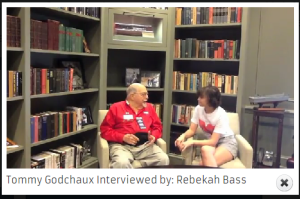Hands On History: Tips for Student Oral Histories
 Oral histories are a wonderful way to make history come alive in the classroom and are an important way to preserve personal stories for future generations. Much like a museum collects artifacts, oral history interviews are a way for students and others to “collect” and record an individual’s memories about their life and historic events. Whether you are a teacher who currently has your students conduct interviews with veterans, or one who is thinking about creating a project like this, The National WWII Museum has some helpful oral history tips for you.
Oral histories are a wonderful way to make history come alive in the classroom and are an important way to preserve personal stories for future generations. Much like a museum collects artifacts, oral history interviews are a way for students and others to “collect” and record an individual’s memories about their life and historic events. Whether you are a teacher who currently has your students conduct interviews with veterans, or one who is thinking about creating a project like this, The National WWII Museum has some helpful oral history tips for you.
Since the Museum’s opening, The National WWII Museum has collected over 7,000 oral history interviews with WWII veterans and civilians. Along the way, Museum scholars and educators have compiled some helpful guidelines for both beginning and more seasoned oral history interviewers. Some of these tips can be found on the Museum’s For Students: Oral History Guidelines webpage. Suggestions include researching and interviewing both WWII veterans (whether they saw combat overseas or not) and civilians on the Home Front, including school-aged children. WWII was a total war and everyone, no matter what age, was expected to contribute to the war effort, so all personal WWII experiences are valuable to collect. As such, the Museum’s Oral History Guidelines page has suggested questions for both military and Home Front interviews.
Once you and your students have identified potential people to interview, it’s important to schedule an initial phone call or in-person meeting to establish basic facts about the person’s life (such as when they enlisted and what unit they were assigned to or what school they attended during the war) to guide your research. This research will help your students to develop more detailed and open-ended questions that will yield more information than basic “yes/no” questions, and show the interviewee that the student takes the interview seriously and is prepared. Other key guidelines include being an active listener, waiting long enough after a question has been asked for the interviewee to collect their thoughts and respond, and having a consent/release form for the person to sign. A sample of this type of form is provided on the Oral History Guidelines page. It is essential to have your interviewee sign this form so that you and your school have permission to record, archive, and to use their interview in the future
Additional ways to prepare your students to be strong interviewers is to have them practice interviewing each other and to study examples of good oral history techniques. A good place to start is by viewing one of the 150 WWII interviews that are currently available online at The Digital Collections of the National WWII Museum website at www.ww2online.org. The Digital Collections will be updated with more interviews, as well as photographic collections in the future, so be sure to check back regularly.
Good luck to you and your students as you explore the personal stories of WWII through oral history interviews! For more classroom lessons ideas and resources, subscribe to the Museum’s free, monthly Calling All Teachers e-newsletter and join us for our October 15 Teacher Appreciation Evening.
Post by Megan Byrnes, K-12 Curriculum Coordinator at The National WWII Museum




Leave a Reply